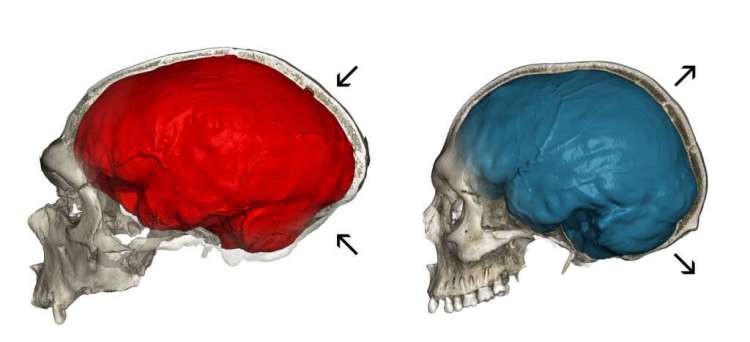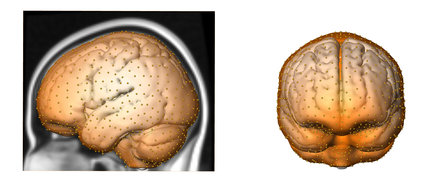De betekenis van de bolvorm van de menselijke hersenen
Inleiding
De menselijke hersenen zijn in de loop van de biologische evolutie uitgegroeid tot een (vrijwel) bolvormig orgaan, wat uniek is voor de menselijke soort. Onderzoekers zijn een evolutionair verband op het spoor tussen die verandering naar de uitzonderlijke bolvorm van het menselijke brein en de verbetering van de wisselwerking tussen de motorische cortex, de basale ganglia en het cerebellum. Deze hersengebieden zijn betrokken bij planning, het leren en het sturen van bewegingen. De basale ganglia dragen ook bij aan cognitieve functies in het geheugen, de aandacht en mogelijk de ontwikkeling van spraak en taal.
De bolvorm van de hersenen is een afspiegeling van de bolvormige wolk van licht en warmte, die de zelfstandige, vrije menselijke geest is. In de loop van de ontwikkelingen is de menselijke geest er steeds beter in geslaagd zich met de hersenen - het besturingsorgaan van zijn stoffelijke levensvorm - te verbinden. Dat heeft tot gevolg gehad dat ook de hersenen bolvormig zijn geworden... volgens Pythagoras en Plato de meest ontwikkelde, volmaakte stereometrische vorm.
Het betreffende artikel
'Genen van Neanderthaler beïnvloeden onze hersenontwikkeling'
Neanderthaler-genen blijken bijvoorbeeld van invloed op de vorm van ons hoofd.
Scientias, Vivian Lammerse, 14-12-2018
Moderne mensen hebben een bolvormige, ronde schedel. Maar kijken we naar onze verre neven de Neanderthalers, dan valt op dat zij juist een langwerpige schedel hebben. Maar wat voor effect heeft dit verschil in schedelvorm? In een nieuwe studie stellen onderzoekers dat dit mogelijk invloed heeft op de manier waarop belangrijke hersengebieden met elkaar zijn verbonden.
Neanderthaler-genen
De onderzoekers verzamelden voor de studie 4.500 mensen van Europese afkomst. Sommigen hebben namelijk nog flarden van Neanderthaler-DNA in hun genoom verstopt zitten, als resultaat van kruisingen tussen Neanderthalers en de vroeg moderne mens. Opvallend genoeg vonden de onderzoekers aanzienlijke verschillen tussen de deelnemers. Zo blijken de mensen die het Neanderthaler-DNA dragen, een iets langwerpigere schedel te hebben.

hersenen van de Neanderthaler en H. sapiens
Het team vond de Neanderthaler-genen terug in de chromosomen 1 en 18. Deze fragmenten bevatten twee genen – UBR4 en PHLPP1 – waarvan al bekend is dat ze een rol spelen in belangrijke aspecten van de hersenontwikkeling. De genen hebben vooral invloed op de basale ganglia en het cerebellum in het brein. En het verband tussen evolutionaire veranderingen in de vorm van het brein en het mechanisme die de basale ganglia en cerebellum beïnvloeden, is best interessant.
"Deze hersengebieden krijgen signalen door van de motorische cortex en zijn betrokken bij de planning, het leren en de coördinatie van bewegingen," legt onderzoeker Philipp Gunz uit. "De basale ganglia dragen ook bij aan diverse cognitieve functies in het geheugen, aandacht, planning, leervaardigheden en mogelijk de evolutie van spraak en taal."
De schedelvorm van de Neanderthaler (links) en de moderne mens (rechts). De pijlen markeren de plekken waar de schedels het meest verschillen.
Afbeelding: Philipp Gunz
De onderzoekers benadrukken dat de effecten van het dragen van het zeldzame Neanderthaler-fragment heel subtiel zijn en alleen detecteerbaar in een zeer grote groep mensen. De onderzoekers willen in vervolgstudies het aantal deelnemers opschalen naar tienduizenden. Ze hopen op die manier misschien wel andere genen op het spoor te komen die invloed hebben op biologische kenmerken van het brein. "De aanpak die we voor de huidige studie hebben ontwikkeld kan breder worden toegepast, om vragen over de evolutie van het menselijk brein op te lossen," besluit onderzoeker Simon Fisher.
Bron:
"Neandertal genes influence brain development of modern humans." - Max Planck Institutes in Europe
Neandertal genes influence brain development of modern humans
DNA fragments from Neandertals in the human genome shed light on brain evolution
December 13, 2018
Brain Neanderthals
A characteristic feature of modern humans is the unusually round skull and brain, in contrast to the elongated shape seen in other human species. An interdisciplinary research team, led by the Max Planck Institutes for Psycholinguistics and Evolutionary Anthropology, brought together fossil skull data, brain imaging and genomics. By studying Neandertal DNA fragments found in the genomes of living Europeans, the scientists have now discovered genes that influence this globular shape.

Neanderthal and Homo sapiens skulls
© CC BY-NC-ND 4.0 (Image: Philipp Gunz)
Modern human skulls have a unique 'globular' (round) shape.
Our closest cousins, the long extinct Neandertals, had the elongated skulls that are typical of most primates. This striking shape difference is suspected to reflect evolutionary changes in the relative sizes of structures of the human brain, perhaps even in the ways that key brain areas are connected to each other. However, brain tissue doesn't itself fossilize, so the underlying biological explanation has remained elusive.
An international research team, led by paleoanthropologist Philipp Gunz from the Max Planck Institute for Evolutionary Anthropology and geneticists Simon Fisher and Amanda Tilot from the Max Planck Institute for Psycholinguistics developed a new strategy to investigate this question. The team combined analysis of fossil skulls, ancient genome sequence data and brain imaging. "Our aim was to identify potential candidate genes and biological pathways that are related to brain globularity," says Tilot. To tightly focus their search, they took advantage of the fact that living humans with European ancestry carry rare fragments of Neandertal DNA buried in their genomes, as a result of interbreeding between Neandertals and the ancestors of modern Europeans. Different people carry different fragments, which are scattered through the genome.

Endocasts of fossil and modern skulls
© CC BY-NC-ND 4.0 (Image: Philipp Gunz)
The researchers first used computed tomographic scans of fossil Neandertal skulls and skulls of modern humans to make endocasts - virtual imprints of the interior of the braincase. They then developed a single measure of globularity, based on the differences in skull shape between humans and Neandertals. Next, the scientists teamed up with colleagues at the Radboud University, the University of Greifswald and UC Irvine, to determine the degree of globularity of thousands of healthy present-day humans, using data from magnetic resonance imaging. Although modern human brain and skull shapes are all clearly distinct from those of Neandertals, the scientists still found considerable differences in globularity among the participants. Finally, the researchers studied the genomes of around 4,500 of the participants to identify the fragments of Neandertal DNA that each person carried. Would any of these Neandertal DNA fragments influence brain globularity in their living human sample?
The team found Neandertal DNA fragments on chromosomes 1 and 18 that were associated with less globular (more elongated) brains. These fragments were associated with altered activity of two genes, UBR4 and PHLPP1, which are already known to play roles in important aspects of brain development (neurogenesis and myelination respectively). The strongest evidence for effects of these Neandertal DNA fragments on gene activity were in the putamen (in the basal ganglia) and the cerebellum. "The potential for links between evolutionary changes in brain globularity and mechanisms affecting the basal ganglia and cerebellum is intriguing", says Gunz. Both structures receive direct input from the motor cortex and are involved in the preparation, learning, and coordination of movements. The basal ganglia also contribute to cognitive functions such as memory, attention, planning, skill learning, and potentially speech and language evolution.

brains of Neanderthaler and H. sapiens
© CC BY-NC-ND 4.0 (Image: Philipp Gunz)
No hard conclusions on cognitive skills
The authors stress that recent archaeological evidence has documented sophisticated symbolic behaviours in Neandertals that had previously been attributed exclusively to modern humans, such as the enigmatic structure built deep inside Bruniquel cave, and Neandertal cave-art from Iberia. As Gunz notes, "The focus of our study is on understanding the unusual brain shape of modern humans. These results cannot be used to make inferences about what Neandertals could or could not do".
"The effects of carrying these rare Neandertal DNA fragments are really subtle, but detectable due to the large sample size", explains Fisher, adding "This is only our first glimpse of the molecular underpinnings of globularity. Like other aspects of brain structure, globularity is a trait that is likely to be influenced by the combined effects of many different genetic variants."
According to the research team, this discovery generates hypotheses that can be tested with new experiments, for example using human neuronal tissue that can be grown in the laboratory. Gunz and Fisher are now scaling-up the approach for investigations in larger samples such as the UK Biobank. They anticipate that future genome-wide screening studies will reveal additional genes associated with globularity, as well as indicate how this fascinating trait is linked to other aspects of human biology.
terug naar het overzicht
terug naar het weblog
^